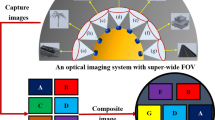Abstract
Mapping the multi-view image group acquired by the sparse camera array into an element image array can effectively improve the display angle of stereoscopic source reconstruction images in the integral imaging display system, and can also avoid the crosstalk problem caused by the use of microlens array. However, the number of multi-view images collected by sparse camera array is small, and it is easy to lose details, which will increase the economic cost or time cost to collect sufficient number of multi-view images. Therefore, we propose a method to generate element image array based on mapping between a small number of multi-view images and homologous pixels. The pixel mapping relationship between multi-view image group and element image array is established. The experimental results show that the element image generated by the method proposed in this paper has a larger display view field and smooth transition of each view interval after stereoscopic source reconstruction.






















Similar content being viewed by others
Data availability
No datasets were generated or analysed during the current study.
References
Zhang, M., Wang, F.Y., Guo, Z., Tang, L.L., Wang, X.: Overview and development of true 3D display technology: principles and perspectives. Pattern Recognit. Artif. Intell. 35(8), 701–717 (2022). https://doi.org/10.16451/j.cnki.issn1003-6059.202208003
Zhang, Y.K., Fu, Y.Q., Wang, H.Q., Li, H.F., Pan, S.W., Du, Y.Z.: High resolution integral imaging display by using a microstructure array. J. Opt. Technol. 86(2), 100–104 (2019). https://doi.org/10.1364/JOT.86.000100
Li, R., Zhang, H.L., Chu, F., Wang, Q.H.: Compact integral imaging 2D/3D compatible dis-play based on liquid crystal micro-lens array. Liq. Cryst. 49(4), 512–522 (2022). https://doi.org/10.1080/02678292.2021.1979115
Park, G., Hong, J., Kim, Y., Lee, B.: Enhancement of viewing angle and viewing distance in integral imaging by head tracking. In: Vancouver Canada, Digital Holography and Three-Dimensional Imaging, 2009, pp. 26–30. https://doi.org/10.1364/DH.2009.DWB27
Watanabe, H., Okaichi, N., Sasaki, H., Kawakita, M.: Pixel-density and viewing-angle enhanced integral 3D display with parallel projection of multiple UHD elemental images. Opt. Express 28(17), 24731–24746 (2020). https://doi.org/10.1364/OE.397647
Wang, Y., Yang, J.X., Liu, L., Piao, Y.: Computational reconstruction of integral imaging based on elemental images stitching. Acta Optica Sinica 39(11), 113–119 (2019). https://doi.org/10.3788/AOS201939.1110001
Kwon, K.C., Erdenebat, M.-U., Alam, M.A., Lim, Y.T., Kim, K.G., Kim, N.: Integral imaging microscopy with enhance depth-of-field using a spatial multiplexing. Opt. Express 24(3), 2072–2083 (2016). https://doi.org/10.1364/OE.24.002072
Peng, Y.Y., Yang, X.T., Zhang, S.J.: Research on micro-lens array for increasing depth of field of integral imaging. Optoelectron. Laser. 31(11), 1225–1230 (2020). https://doi.org/10.16136/j.joel.2020.11.0218
Miura, M., Okaichi, N., Ara, J., Mishina, T.: Integral three-dimensional capture system with enhanced viewing angle by using camera array. In: Proceedings of SPIE The International Society for Optical Engineering, 939106–7 (2015). https://doi.org/10.1117/12.2078954
Mehdi, D., Javidi, B., Watson, E.A.: Three dimensional imaging with randomly distributed sensors. Opt. Express 16(9), 6368–6377 (2018). https://doi.org/10.1364/OE.16.006368
Guo, M., Si, Y.J., Lyu, Y.Z., Wang, S.G., Jin, F.S.: Elemental image array generation based on discrete viewpoint pickup and window interception in integral imaging. Appl. Opt. 54(4), 876–884 (2015). https://doi.org/10.1364/AO.54.000876
Shi, X., Ai, L.Y., Yu, M., Jin, X.Y., Chen, Y.Z.: Full-parallax three dimensional display based on light field camera. Acta Optica Sinica 40(7), 98–107 (2020). https://doi.org/10.3788/AOS202040.0711005
Yim, J.K., Kim, Y.M., Min, S.: Real object pickup method for real and virtual modes of integral imaging. Opt. Eng. 53(7), 073109 (2014). https://doi.org/10.1117/1.OE.53.7.073109
Yuan, X.Y., Ji, M.Q., Wu, J.M., Brady, D.J., Dai, Q.H., Fang, L.: A modular hierarchical array camera. Light Sci. Appl. 10(1), 37 (2021). https://doi.org/10.1038/s41377-021-00485-x
Guo, M., Lyu, Y.Z., Wang, S.G.: Real scene pickup method of elemental image array based on convergent camera array. IEEE Access. 8, 68439–68448 (2020). https://doi.org/10.1109/ACCESS.2020.2986057
Ren, H., Wang, Q.H., Xing, Y., Zhao, M., Lou, L., Deng, H.: Super-multiview integral imaging scheme based on sparse camera array and CNN super resolution. Appl. Opt. 58(5), A190–A196 (2019). https://doi.org/10.1364/AO.58.00A190
Kwon, K.H., Erdenebat, M.U., Lim, Y.T., Jeong, J.R., Kim, M.Y., Kim, N.: High-quality 3D display for integral imaging microscope using deep learning depth estimation algorithm. In: Conference on Lasers and Electro-Optics Pacific Rim. pp. 1–2 (2020). https://doi.org/10.1364/CLEOPR.2020.P4_11
Zhang, Y., Li, T., Zhang, Y., Chen, P., Qu, Y., Wei, Z.: Computational super resolution imaging with a sparse rotational camera array. IEEE Trans. Comput. Imaging 9, 425–434 (2023). https://doi.org/10.1109/TCI.2023.3265919
Hu, X.L.: Design and implementation of integral imaging system based on sparse camera array. Xi’an Univ. Technol (2022). https://doi.org/10.27398/d.cnki.gxalu.2021.001068
Guyu, J.N.: Research on elemental image generation and 3D reconstruction based on integral imaging technology. Changchun Univ. Sci. Technol. (2022). https://doi.org/10.26977/d.cnki.gccgc.2022.000006
Wang, Q., Piao, Y.: Depth estimation of supervised monocular images based on semantic segmentation. Visual Commun. Image Represent. 90, 103753 (2023). https://doi.org/10.1016/j.jvcir.2023.103753
Deng, H., Lv, G.J., Wu, F., Yang, M., Deng, H.: Crosstalk-free integral imaging 3D display with full stereo viewing area. Laser Optoelectron. Progr. 60(08), 296–301 (2023). https://doi.org/10.3788/LOP222816
Acknowledgements
This work was supported in part by the Project of the Jilin Provincial Department of Science and Technology under Grant 20220201062GX.
Author information
Authors and Affiliations
Contributions
YP conducted model construction and algorithm research. QW built the model, researched the algorithm and wrote the manuscript. NQ and ZCX conducted data collection for the experiment.
Corresponding author
Ethics declarations
Conflict of interest
The authors declare no competing interests.
Additional information
Publisher's Note
Springer Nature remains neutral with regard to jurisdictional claims in published maps and institutional affiliations.
Rights and permissions
Springer Nature or its licensor (e.g. a society or other partner) holds exclusive rights to this article under a publishing agreement with the author(s) or other rightsholder(s); author self-archiving of the accepted manuscript version of this article is solely governed by the terms of such publishing agreement and applicable law.
About this article
Cite this article
Wang, Q., Piao, Y., Qi, N. et al. Research on element image array generation method based on small number of multi-view images and homologous pixels mapping. SIViP 19, 155 (2025). https://doi.org/10.1007/s11760-024-03727-8
Received:
Revised:
Accepted:
Published:
DOI: https://doi.org/10.1007/s11760-024-03727-8




